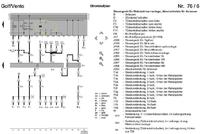

Czy wolisz polską wersję strony elektroda?
Nie, dziękuję Przekieruj mnie tam .
.
tzok wrote:What is J2? It goes somewhere further... High beam is 56a, low beam is 56b, 58 is the parking lamps.
I can't read the function of the E4 switch from this schematic. The legend and the rest of the schematic are missing. What car does this part of the schematic apply to? VW is not my hobbythe switching off of the dipped headlights depends on the version of the lamps, when they are on dual filament bulbs (e.g. H4) they are switched off, when they are on separate bulbs, they usually light simultaneously.
tzok wrote:In my opinion, this is a light horn, i.e. in one position you flash the long and the low beam (even if they were not on), and in the opposite position you turn on only the long (the low beam shines "through" the light switch, which is not in this diagram).
hobbista wrote:That is, in this situation, the light switch is loaded with 4 bulbs?Long-range switch - E4 short circuits 56 with 56a. Both bulbs are lit.
hobbista wrote:
The so called click regardless of the position of the light switch - connects 30 to 56a.